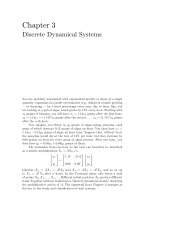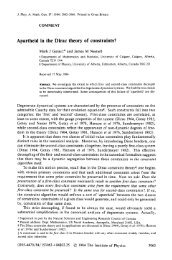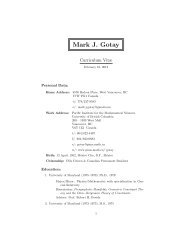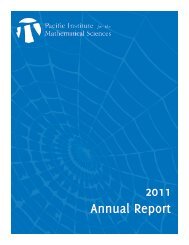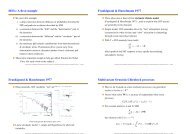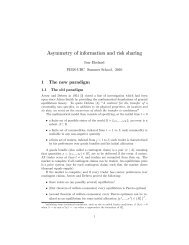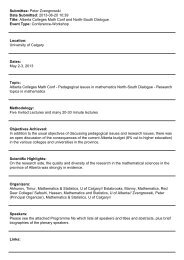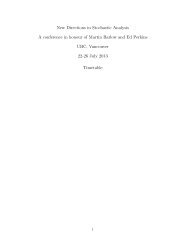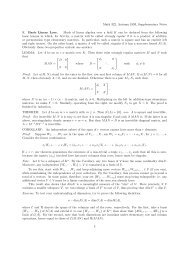37 PRIMA 2013 AbstractsKyoto University, Japankumagai@m<strong>at</strong>h.kyoto-u.ac.jpWe will consider the following two models and establishquenched invariance principles;1. Simple random walks on the infinite clusters for supercriticalpercol<strong>at</strong>ions on half and quarter planes in d-dimensional Euclidean spaces.2. Uniform elliptic divergence forms with random st<strong>at</strong>ionarycoefficients on cones in Euclidean spaces.Note th<strong>at</strong> because of the lack of transl<strong>at</strong>ion invariancewe cannot apply the method of the ’corrector’. ÂăInsteadwe make full use of the he<strong>at</strong> kernel estim<strong>at</strong>es andDirichlet form techniques to resolve the problem. This isa joint work with Z.Q. Chen (Se<strong>at</strong>tle) and D.A. Croydon(Warwick).Ultrametric potentialsJaime San MartinUniversidad de Chile, Chilejsanmart@dim.uchile.clIn m<strong>at</strong>rix theory an important question is the so calledinverse M-m<strong>at</strong>rix problem. Recall th<strong>at</strong> an M-m<strong>at</strong>rix is anonsingular m<strong>at</strong>rix whose off diagonal elements are nonpositiveand whose inverse is non-neg<strong>at</strong>ive. So, the questionis which nonneg<strong>at</strong>ive m<strong>at</strong>rices are inverses of M-m<strong>at</strong>rices?.The inverse of an M-m<strong>at</strong>rix is n<strong>at</strong>urally linked to thepotential of a transient Markov chain and then one canuse a Theorem of Choquet-Deny to characterize these m<strong>at</strong>rices.The main drawback of this result is th<strong>at</strong> the characteriz<strong>at</strong>ionis difficult to check for a given m<strong>at</strong>rix.We connect this problem with the notion of ultrametricm<strong>at</strong>rices and filtered m<strong>at</strong>rices. Using these conceptswe provide a large class of inverse M-m<strong>at</strong>rices th<strong>at</strong> are describedin combin<strong>at</strong>orial terms. Special <strong>at</strong>tention is givento one dimensional random walks and random walks ontrees. We also discuss extensions to diffusions.Some of the useful bibliography is given below.[1] C. Dellacherie, S. Martínez and J. San Martín, Ultrametricm<strong>at</strong>rices and induced Markov chains. Advancesin Applied M<strong>at</strong>hem<strong>at</strong>ics, 17 (1996), 169–183.[2] C. Dellacherie, S. Martínez and J. San Martín, Descriptionof the Sub-Markov kernel associ<strong>at</strong>ed to generalizedultrametric m<strong>at</strong>rices. An algorithmic approach.Linear Algebra and its Applic<strong>at</strong>ions, 318 (2000), 1-21.[3] C. Dellacherie, S. Martínez, J. San Martín,Hadamard functions of inverse M-M<strong>at</strong>rices. SIAM Journalon M<strong>at</strong>rix Analysis and Applic<strong>at</strong>ions (2009) 31, 2,289–315.[4] C. Dellacherie, S. Martínez S., J. San Martín, Ultrametricand tree potential. Journal of Theoretical Probability(2009) 22, 2, 311–347.[5] F.R. Gantmacher and M.G. Krein, Oszill<strong>at</strong>ionsm<strong>at</strong>rizen,Oszill<strong>at</strong>ionskerne und kleine Schwingungen mechanischerSysteme, (1960) Akademie-Verlag, Berlin.[6] T.L. Markham, Nonneg<strong>at</strong>ive m<strong>at</strong>rices whose inversesare M-m<strong>at</strong>rices. Proceedings of the AmericanM<strong>at</strong>hem<strong>at</strong>ical Society, 36 (1972), 326–330.[7] S. Martínez, G. Michon and J. San Martín, Inversesof ultrametric m<strong>at</strong>rices are of Stieltjes types, SIAM JournalM<strong>at</strong>rix Analysis and its Applic<strong>at</strong>ions, 15 (1994), 98–106.[8] S. Martínez, J. San Martín, X. Zhang. A new classof inverse M-m<strong>at</strong>rices of tree-like type. SIAM Journalon M<strong>at</strong>rix Analysis and Applic<strong>at</strong>ions, 24-4 (2003), 1136–1148.[9] S. Martínez, J. San Martín, X. Zhang. A class ofM-m<strong>at</strong>rices whose graphs are trees. Linear and MultilinearAlgebra 52-5 (2004), 303–319.[10] J.J. McDonald, M. Neumann, H. Schneider,M.J. Ts<strong>at</strong>someros, Inverse M-m<strong>at</strong>rix inequalities and generalizedultrametric m<strong>at</strong>rices. Linear Algebra and its Applic<strong>at</strong>ions,220 (1995), 321–341.[11] J.J. McDonald, R. Nabben, M. Neumann,H.Schneider, M.J. Ts<strong>at</strong>someros Inverse tridiagonalZ-m<strong>at</strong>rices. Linear and Multilinear Algebra 45 (1998),75–97.[12] R. Nabben, On Green’s m<strong>at</strong>rices of trees. SIAMJournal M<strong>at</strong>rix Analysis and its Applic<strong>at</strong>ions, 22, no. 4,(2001), 1014–1026.From Stein’s method to self-normalized moder<strong>at</strong>edevi<strong>at</strong>ionsQi-Man ShaoThe Chinese University of Hong Kong, Hong Kong, Chinaqmshao@cuhk.edu.hkIn this talk we shall review recent developments onStein’s method and self-normalized limit theory. The focuswill be on randomized concentr<strong>at</strong>ion inequalities andtheir applic<strong>at</strong>ions to self-normalized Cramer type moder<strong>at</strong>etheorems.Backward stochastic differential equ<strong>at</strong>ionsdriven by G-Brownian motionYongsheng SongChinese Academy of Sciences, Chinayssong@amss.ac.cnIn this paper, we study the backward stochastic differentialequ<strong>at</strong>ions driven by G-Brownian motion inthe following form: Y t = ξ + ∫ Tt f(s, Y s, Z s)ds +∫ Tt g(s, Y s, Z s)d〈B〉 s − ∫ Tt Z sdB s − K T + K t. Under aLipschitz condition of f and g in Y and Z, the existenceand uniqueness of the solution (Y, Z, K) is proved, whereK is a decreasing G-martingale.Symmetric rearrangements around infinitywith applic<strong>at</strong>ions to Lévy processesRongfeng SunN<strong>at</strong>ional University of Singapore, Singaporem<strong>at</strong>sr@nus.edu.sgWe prove a new rearrangement inequality for multipleintegrals, which partly generalizes a result of Friedbergand Luttinger (1976) and can be interpreted as involvingsymmetric rearrangements of domains around infinity.As applic<strong>at</strong>ions, we prove two comparison results forgeneral Lévy processes and their symmetric rearrangements.The first applic<strong>at</strong>ion concerns the survival probabilityof a point particle in a Poisson field of moving trapsfollowing independent Lévy motions. We show th<strong>at</strong> thesurvival probability can only increase if the point particledoes not move, and the traps and the Lévy motions aresymmetrically rearranged. This essentially generalizes anisoperimetric inequality of Peres and Sousi (2011) for theWiener sausage. In the second applic<strong>at</strong>ion, we show th<strong>at</strong>the q-capacity of a Borel measurable set for a Lévy processcan only increase if the set and the Lévy processare symmetrically rearranged. This result generalizes aninequality obtained by W<strong>at</strong>anabe (1983) for symmetricLévy processes. Based on joint work with Alex Drewitzand Perla Sousi.Bismut formula and gradient estim<strong>at</strong>es forSDEs driven by multiplic<strong>at</strong>ive Lévy noiseFeng-Yu Wang, Lihu Xu & Xicheng ZhangBeijing Normal University, Chinawangfy@bnu.edu.cnBismut formula and Gradient estim<strong>at</strong>es are derived forthe semigroup associ<strong>at</strong>ed to a class of stochastic differentialequ<strong>at</strong>ions driven by multiplic<strong>at</strong>ive Lévy noise, where
38 PRIMA 2013 Abstractsthe noise is realized as a subordin<strong>at</strong>ion of the Brownianmotion. In particular, the estim<strong>at</strong>es are sharp forα-stable type noises. To derive these estim<strong>at</strong>es, a newderiv<strong>at</strong>ive formula is established for the semigroup by usingthe Malliavin calculus and a finite-jump approxim<strong>at</strong>ionargument.Viscosity solutions of p<strong>at</strong>h dependent PDEsJianfeng ZhangUniversity of Southern California, USAjianfenz@usc.eduP<strong>at</strong>h Dependent PDEs (PPDEs, for short) is a convenienttool to characterize the value functions of varioustypes of stochastic control problems in non- Markovianframework. Its typical examples include Backward SDEs(semi- linear PPDEs), second order BSDEs (p<strong>at</strong>h dependentHJB equ<strong>at</strong>ions), p<strong>at</strong>h dependent Bellman-Isaacsequ<strong>at</strong>ions, and Backward Stochastic PDEs. PPDEs canrarely have classical solutions. In this talk we shall proposea notion of viscosity solutions for PPDEs and establishits wellposedness. Our definition relies heavily on theFunctional Ito formula initi<strong>at</strong>ed by Dupire. Unlike theviscosity theory of standard PDEs, the main difficultyin p<strong>at</strong>h dependent case is th<strong>at</strong> the st<strong>at</strong>e space is not locallycompact. To overcome such difficulty, we replacethe pointwise maximiz<strong>at</strong>ion in standard theory with anoptimal stopping problem under Peng’s nonlinear expect<strong>at</strong>ion.The talk will be based on joint works with NizarTouzi, and Ibrahim Ekren, Christian Keller, Triet Pham.Special Session 19Represent<strong>at</strong>ion Theory and C<strong>at</strong>egorific<strong>at</strong>ionGeometric reciprocity for algebraic tori overnon-Archimedean local fieldsClifton CunninghamUniversity of Calgary, Canadacunning@m<strong>at</strong>h.ucalgary.caRecent work with David Roe has shown th<strong>at</strong> the geometriz<strong>at</strong>ionof admissible characters of T (K), where Tis an algebraic torus over a non-Archimedean field K, isachieved by introducing the tensor c<strong>at</strong>egory of charactersheaves on the Greenberg transform of the Neron modelof T . On the other hand, earlier worth with Achar, Kamgarpourand Salmasian, closely rel<strong>at</strong>ed to ideas of Vogan,shows th<strong>at</strong> the geometriz<strong>at</strong>ion of Langlands parametersfor T is achieved by passing to the c<strong>at</strong>egory of equivariantperverse sheaves on an ind-variety formed from L T .In this talk I will use the class field theory of Serre andHazewinkel to rel<strong>at</strong>e these two c<strong>at</strong>egories.Schubert calculus and cohomology of LiegroupsHaibao DuanInstitute of M<strong>at</strong>hem<strong>at</strong>ics, Chinese Academy of Sciences,Chinadhb@m<strong>at</strong>h.ac.cnThe problem of determining the cohomology of Lie groupswas raised by E. Cartan in 1929, and has been a focus ofalgebraic topology for the fundamental roles of Lie groupsplaying in geometry and topology. On the other handSchubert calculus begun with the intersection theory ofthe 19 century, and clarifying this calculus had been amajor theme of the 20 century algebraic geometry.We bring a connection between these two topics bothwith distinguished historical backgrounds, and demonstr<strong>at</strong>ehow Schubert calculus is extended as to give anexplicit and unified construction of the integral cohomologyrings of all compact and 1-connected Lie groups.Vanishing properties of Jack polynomialsStephen GriffethUniversidad de Talca, Chilesgriffeth@inst-m<strong>at</strong>.utalca.cl(Joint work with Christine Berkesch and Steven Sam)We describe some interactions between represent<strong>at</strong>ionsof r<strong>at</strong>ional Cherednik algebra, especially unitary represent<strong>at</strong>ions,and questions arising in combin<strong>at</strong>orial commut<strong>at</strong>ivealgebra and m<strong>at</strong>hem<strong>at</strong>ical physics. These questionsall have to do with highly symmetric linear subspacearrangements and the ideals of polynomials vanishingon them. Among other things, we will indic<strong>at</strong>e howto use represent<strong>at</strong>ion theory to prove a number of conjecturesof Bernevig and Haldane on the order of vanishingof certain Jack polynomials along these arrangements,and present our own conjecture describing a Bernstein-Gelfand-Gelfand type resolutions of unitary represent<strong>at</strong>ionsof the Cherednik algebra. Any such resolution isautom<strong>at</strong>ically a minimal free resolution for the ideal ofthe corresponding linear arrangement, so we predict acombiantorial formula for the graded equivariant Bettinumbers of these ideals.The modular generalized Springer correspondenceAnthony HendersonUniversity of Sydney, Australiaanthony.henderson@sydney.edu.auGiven a connected reductive algebraic group G with Weylgroup W , the Springer correspondence realizes the c<strong>at</strong>egoryof represent<strong>at</strong>ions of W as a quotient of the c<strong>at</strong>egoryof G-equivariant perverse sheaves on the nilpotentcone. In the original definition, the represent<strong>at</strong>ions andsheaves were over a field of characteristic zero, but wehave recently shown th<strong>at</strong> the same formalism works withmodular coefficients, where the c<strong>at</strong>egories are no longersemisimple. In the characteristic-zero case, Lusztig defineda generalized Springer correspondence to interpretthe whole c<strong>at</strong>egory of G-equivariant perverse sheaves onthe nilpotent cone in terms of represent<strong>at</strong>ions of rel<strong>at</strong>iveWeyl groups. We define and determine a modular generalizedSpringer correspondence in the case G = GL(n).This gives a geometric explan<strong>at</strong>ion for the fact th<strong>at</strong>, inthe modular case, the c<strong>at</strong>egory of modules over the Schuralgebra can be obtained by successive recollements of c<strong>at</strong>egoriesof represent<strong>at</strong>ions of suitable products of symmetricgroups.Knot invariants and their c<strong>at</strong>egorific<strong>at</strong>ions viaHowe dualityAaron LaudaUniversity of Southern California, USAlauda@usc.eduIt is a well understood story th<strong>at</strong> one can extract linkinvariants associ<strong>at</strong>ed to simple Lie algebras. These invariantsare called Reshetikhin-Turaev invariants and thefamous Jones polynomial is the simplest example. Kauffmanshowed th<strong>at</strong> the Jones polynomial could be describedvery simply by replacing crossings in a knot diagram byvarious smoothings. In this talk we will explain Cautis-Kamnitzer-Lic<strong>at</strong>a’s simple new approach to understandingthese invariants using basic represent<strong>at</strong>ion theory andthe quantum Weyl group action. Their approach is basedon a version of Howe duality for exterior algebras calledskew-Howe duality. Even the graphical (or skein theory)description of these invariants can be recovered in an elementaryway from this d<strong>at</strong>a. The advantage of this approachis th<strong>at</strong> it suggests a ‘c<strong>at</strong>egorific<strong>at</strong>ion’ where knothomology theories arise in an elementary way from higherrepresent<strong>at</strong>ion theory and the structure of c<strong>at</strong>egorifiedquantum groups.Center <strong>at</strong> the critical level and commut<strong>at</strong>ivesubalgebras
- Page 2 and 3:
1PRIMA 2013-Table of ContentsTable
- Page 4 and 5:
3PRIMA 2013-OrganizationOrganizatio
- Page 6 and 7:
5PRIMA 2013-OrganizationYoshikazu G
- Page 8 and 9:
7PRIMA 2013-Useful InformationUsefu
- Page 10 and 11:
9PRIMA 2013-Useful InformationTaxi:
- Page 12 and 13:
11PRIMA 2013-Useful Informationmath
- Page 14 and 15:
13PRIMA 2013 Program-Schedule-at-a-
- Page 16 and 17:
15PRIMA 2013 Program-Monday, June 2
- Page 18 and 19:
17PRIMA 2013 Program-Monday, June 2
- Page 20 and 21:
19PRIMA 2013 Program-Monday, June 2
- Page 22 and 23:
21PRIMA 2013 Program-Monday, June 2
- Page 24 and 25:
23PRIMA 2013 Program-Tuesday, June
- Page 26 and 27:
25PRIMA 2013 Program-Tuesday, June
- Page 29 and 30:
28PRIMA 2013 Program-Tuesday, June
- Page 31 and 32:
30PRIMA 2013 Program-Tuesday, June
- Page 33 and 34: 32PRIMA 2013 Program-Wednesday, Jun
- Page 35 and 36: 34PRIMA 2013 Program- Thursday, Jun
- Page 37 and 38: 36PRIMA 2013 Program- Thursday, Jun
- Page 39 and 40: 38PRIMA 2013 Program- Thursday, Jun
- Page 41 and 42: 40PRIMA 2013 Program- Thursday, Jun
- Page 43 and 44: 42PRIMA 2013 Program- Friday, June
- Page 45 and 46: 44PRIMA 2013 Program- Friday, June
- Page 48 and 49: 1 PRIMA 2013 AbstractsContents1 Pub
- Page 50 and 51: 3 PRIMA 2013 Abstractsof subfactors
- Page 52 and 53: 5 PRIMA 2013 AbstractsprocessesXu S
- Page 54 and 55: 7 PRIMA 2013 AbstractsIn this talk
- Page 56 and 57: 9 PRIMA 2013 Abstractsindependently
- Page 58 and 59: 11 PRIMA 2013 AbstractsEnumerating,
- Page 60 and 61: 13 PRIMA 2013 AbstractsRyuhei Uehar
- Page 62 and 63: 15 PRIMA 2013 AbstractsIn this talk
- Page 64 and 65: 17 PRIMA 2013 AbstractsSpecial Sess
- Page 66 and 67: 19 PRIMA 2013 Abstractscritical slo
- Page 68 and 69: 21 PRIMA 2013 AbstractsSpecial Sess
- Page 70 and 71: 23 PRIMA 2013 Abstractsstrictly awa
- Page 72 and 73: 25 PRIMA 2013 AbstractsPedram Hekma
- Page 74 and 75: 27 PRIMA 2013 Abstractsis well-know
- Page 76 and 77: 29 PRIMA 2013 Abstractssolid substr
- Page 78 and 79: 31 PRIMA 2013 AbstractsRapoport-Zin
- Page 80 and 81: 33 PRIMA 2013 Abstractssense. Our a
- Page 82 and 83: 35 PRIMA 2013 AbstractsIn an econom
- Page 86 and 87: 39 PRIMA 2013 AbstractsAlexander Mo
- Page 88 and 89: 41 PRIMA 2013 AbstractsOsamu SaekiK
- Page 90 and 91: 43 PRIMA 2013 Abstractsopen Delzant
- Page 92 and 93: 45 PRIMA 2013 AbstractsJian ZhouTsi
- Page 94 and 95: 47 PRIMA 2013 AbstractsJiaqun WeiNa
- Page 96 and 97: 49 PRIMA 2013 Abstractsthe end of 2
- Page 98 and 99: 51 PRIMA 2013 AbstractsJongyook Par
- Page 100 and 101: 53 PRIMA 2013 AbstractsPancyclicity
- Page 102 and 103: 55 PRIMA 2013 AbstractsEfficient nu
- Page 104 and 105: 57 PRIMA 2013 Abstractsand fountain
- Page 106: 59 PRIMA 2013 Abstractsformula esti



